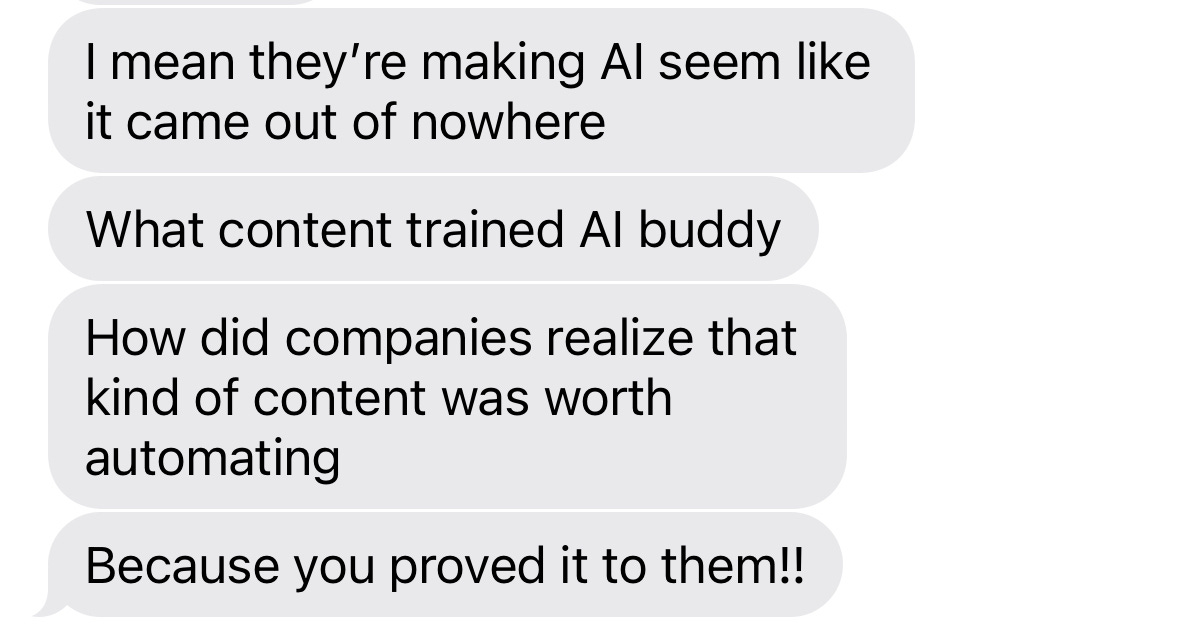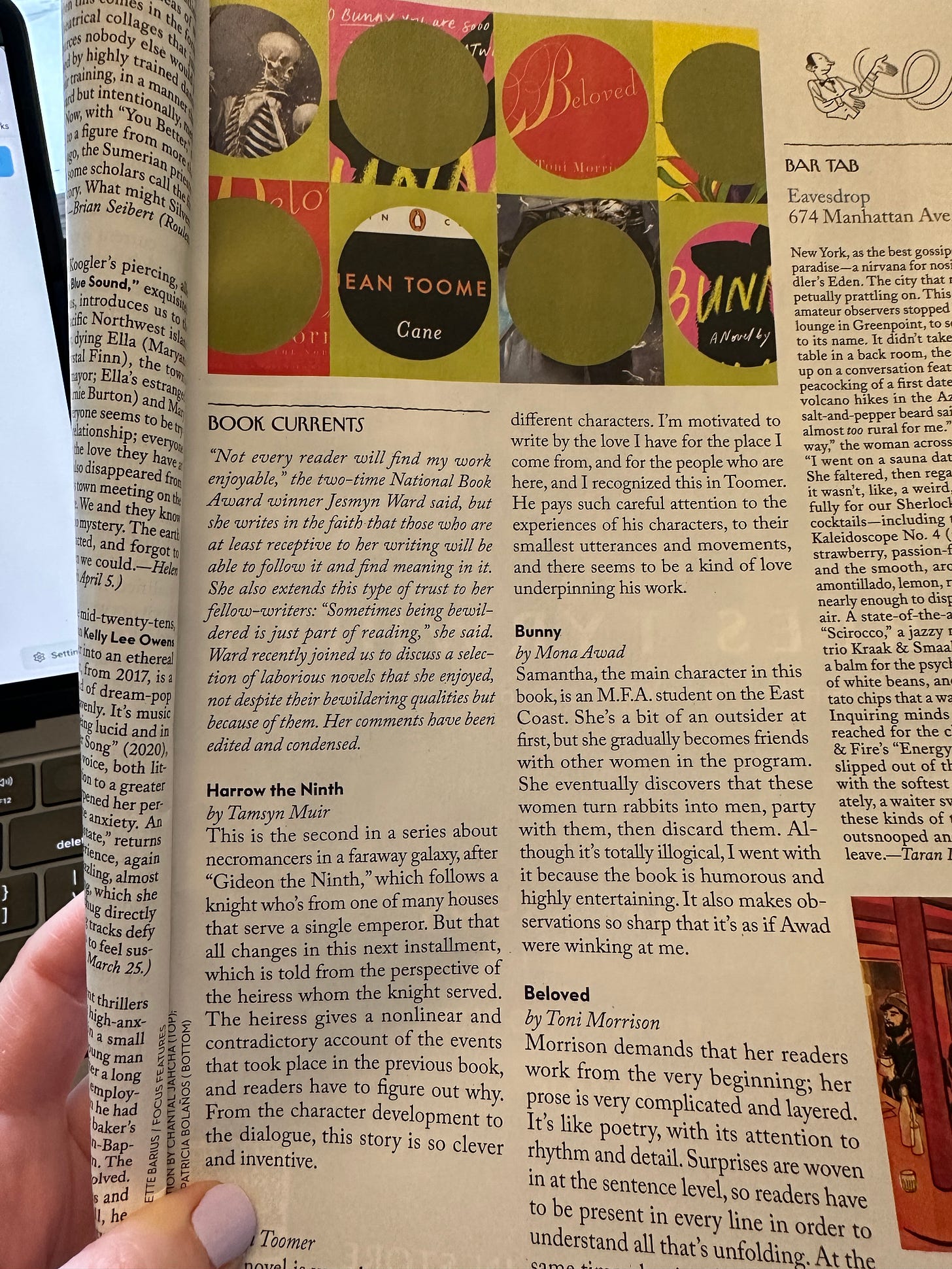we all want to be relevant
My forthcoming novel is about a 39-year-old woman named Dayna who has aged out of the media industry:
I’d started my career covering celebrities—their vices, their breakups, their crashes, their comebacks—but once they started using social media, there was less of a need for editorial. Print magazines starved to death. I survived the media industry’s pivot to digital and the pivot to video and the pivot to podcasting but it was the collapse of live events, after we’d all pivoted to live events, that crushed me. On paper, I was “deeply passionate about community building” and “comfortable in a fast-paced environment,” but my years of experience had become a liability. It signaled to potential employers that I was old and expensive. On my resume, I deleted my first two jobs out of college, and changed the date of my graduation so I appeared thirty-four. It still wasn’t enough.
All the open roles are in social, not editorial.
I thought of Dayna when I read the Times piece on Gen X career meltdowns (gift link):
If you entered media or image-making in the ’90s — magazine publishing, newspaper journalism, photography, graphic design, advertising, music, film, TV — there’s a good chance that you are now doing something else for work. That’s because those industries have shrunk or transformed themselves radically, shutting out those whose skills were once in high demand.
Replace “the ’90s” with “the ’00s” and this describes the situation of many elder millennials who started careers in digital media when digital media was, well, new. I was an assistant at the New Yorker during the 2008 financial crisis; when Condé Nast publications had to slash their budgets by 25%, I should have been a first draft pick for layoffs, but my boss fought for my role, and told the Managing Editor she could squeeze more value from me by just assigning me more work, like writing for the magazine’s new “blog,” named after the book bench in the office where assistants lifted review copies to bring to the Strand to sell for extra cash.
One of the architects of digital media was Jonah Peretti, co-founder of BuzzFeed and The Huffington Post.
He ran experiments to determine what made people share content on the internet. What he found, as Ben Smith writes in Traffic, was that “people shared content that reflected well on them…they were more likely to share a post about earthquake relief than one about celebrity gossip. They shared content connected to their identity. They shared things that made them look clever and funny….Jonah’s approach was a radically new and abstract way of thinking about media—to focus on its psychological effect rather than on what it was actually about.”
This explains why all you’ll see today online are White Lotus memes—we’re living in the internet that Peretti built.
In May of 2009, Peretti applied what he’d learned about viral content, by pulling a prank on Ashton Kutcher, creator of the reality show Punk’d. After Kutcher shared a BuzzFeed link on Twitter, Jonah posted, “Yo Ashton! Thanks for Tweeting!”
Smith tells the rest of the story:
When Kutcher didn’t respond to that post, Jonah posted another one acting like a deranged fan. “You think you can just tweet a few BuzzFeed links and then just IGNORE me when I respond? When I offer to give you your own freakin’ BuzzFeed badge??!!! I was YOUR BIGGEST FAN!!!! How can you just IGNORE THE FANS who made you who you are?? That means you just turned your biggest fan into YOUR BIGGEST ONLINE NIGHTMARE. I am pleased to announce BuzzFeed.com’s newest weekly feature. It’s called ————> F**K ASHTON!!!!!, BuzzFeed readers can email jonah@buzzfeed.com to suggest what I should post next week. And I will keep doing it until you apologize for ignoring me,” he wrote, threatening a post called “TOP 3 THINGS THAT ARE LAME ABOUT ASHTON KUTCHER!!!!!!!!"
Kutcher left an earnest apology on Peretti’s voicemail, which Peretti posted to BuzzFeed. It got more than 20,000 views (this is what counted for viral at the time) and made Page Six.
I need you to understand who Peretti was in 2009, and how much he influenced what we know now about why people share content, before I show you “The Anti-SNARF Manifesto” he posted on February 11 of this year.
SNARF stands for Stakes/Novelty/Anger/Retention/Fear. Peretti writes:
Content creators exaggerate stakes to make their content urgent and existential. They manufacture novelty and spin their content as unprecedented and unique. They manipulate anger to drive engagement via outrage. They hack retention by withholding information and promising a payoff at the end of a video. And they provoke fear to make people focus with urgency on their content.
My fictional character Dayna takes a job managing a D-list TikTok hype house, where she must quickly learn the principles of SNARF or else face her continued irrelevance. To land a major sponsor, she has to create content people want to watch: by staging a campaign around a missing influencer (stakes, novelty, anger, retention, fear).
Peretti is worried that the playbook he created in the aughts is now being used by AI at scale and it’s made the internet—by Peretti’s own account—a much worse place to be.
“To be discussed,” I texted my friend Rebecca this morning, with a link to the anti-SNARF manifesto. Rebecca knows more about AI than anyone I know.
As an alternative, Peretti promises to “fight back.” At BuzzFeed, “[we’ll] do the doomscrolling for you, so you can follow the biggest trends, find the hidden gems, and be in the loop without wasting your time and risking your mental health. We will also counter the anger and fear with a sense of humor, laughing at the buffoonery and ridiculousness of the most powerful people.”
This is the weak position of a man at the helm of a company that lost market share in the attention economy to TikTok a long time ago. Like Sean Manning, who I wrote about last week for premium subscribers, Peretti is a high-powered middle-aged media executive trying to stay relevant in a culture that is changing around him.
And there’s something poignant about that. I sympathize! As Steven Kurutz wrote in the Times, “it isn’t easy to reinvent yourself in your 50s, especially in industries that put a premium on youth culture.”
I’ve been on the internet for more than 25 years. When I take the long view on what I’ve seen, and learned, and experienced during that time, I sometimes miss the way things used to be, but at the same time, I feel a surprising amount of security.
I’ve been following the same playbook the whole time: connect with other people and share art. I’ve gone to AWP to meet internet friends; I’ve hosted multiple in-person reading series1 for writers I met online; I even organized conferences for 2,000 writers based on an online community. I posted yesterday about the zines I’ve been collecting from writers and poets and photographers since the early 2000s, and the zine I just bought from
on Substack.The internet has evolved but people’s desires have not. Writers want to be read, so you befriend other writers by engaging with their work. Readers want to be entertained, or inspired, or educated, so you engage them by giving them more of what they want.
Today I run a business helping other writers get better at creating content and growing their networks and their audiences on the internet. I haven’t had to reinvent myself. I’ve only had to figure out how to effectively teach what I’ve learned to do well.
I know that you are mired in opinionated commentary about internet culture, and the problems with the media industry, and the risks and harms of being online. I wrote a gothic novel about the internet because I imagine us all as Little Edies in Grey Gardens: we’re desperate to escape and incapable of leaving.
Because this is a newsletter for professional writers, I think there are two simple questions you can ask yourself to focus your attention and your efforts:
Is doing this thing (writing a Substack newsletter, posting to Instagram, etc.) connecting me to other human beings or is it alienating me from them?
Does the content I’m creating online help people discover my art?
Content begets content
Last August, I wrote about the difference between writing (my art) and content. Francis Zierer interviewed me about this for his podcast (more content) and then
created content from my podcast interview. I think of content as dynamic and alive, in conversation with other people. My art is polished, perfected, finished. Brands create content to sell products. Media companies create content to generate attention for their journalism. I know some of you think content creation is beneath you, but look at this piece of content the New Yorker published in the pages of the print magazine (!!):Writing satire in an era of clowns
You can now listen to my wide-ranging (and funny) conversation with Nick Gillespie and Julius Taranto, about writing satire at a time when everything seems like a joke, on Apple podcasts, Spotify, or YouTube.







My god the hype houses. I tried watching content on what I think is Tiktok's top hype house right now: The Bop House. And I just couldn't! I couldn't consume it! I used to not understand how people find this so consumable. But after reading that old Vox article explaining how TikTok shows the "oppressively plain" taste of the majority - I finally got it.
Your novel quote is really strong. I look forward to getting a copy soon ❤️
Can't wait to read, Leigh!